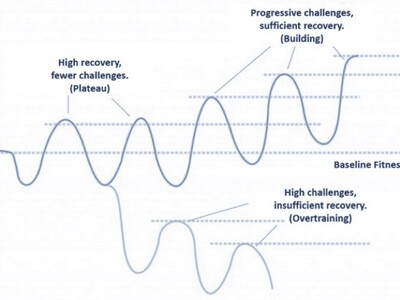My wife reckons timing is everything. If we’d met a few years earlier, she’d have had better things to spend her time on than hanging out with a flirtatious, aspiring multisport athlete. Had we met a year or two later, she’d possibly have been wise enough to know better, or already married someone smarter and better looking. Just as well I caught her at the right moment in time.
My coach uses a piano analogy to emphasise the importance of timing when it comes to structured training…
We all have an idea of what ‘types’ of training exist. Examples might include a long easy run for general endurance, a bunch of short hard intervals on the bike to build specific fitness qualities, or a strength session in the gym to build tissues more resilient to loads and impacts.
But if we choose to do these sessions randomly, or based on what suits us right now, we’re walking up to the piano and hitting the keys in random order. Imagine the noise this would make? I dare say anyone within earshot would make a beeline for the nearest exit.
With some considered planning, effective time management and commitment to our goals, we can look to place the ‘types’ of training sessions on specific days, weeks and months, in order to maximise the training effect (and recovery). This would be the musical equivalent to hitting the keys of the piano in a deliberate order, where the timing of your actions would create music rather than noise.
You're using the same piano (or completing the same training session), but the difference between a mass exodus and an audience enthralled is simply your timing. The difference between a sub-par performance on race day and one that aligns with your goals can often be the timing of each training session within the context of your overall life.
How to maximise training stress-adaptation
Let’s be realistic for a moment, life can be unpredictable. When someone I coach has to switch their swim and bike sessions to opposite days to fit around family and work commitments, it’s usually a case of ‘doing what needs to be done to get the training done’.
Swimming on Tuesday rather than Wednesday is better than not swimming at all (usually), but it’s also worth remembering that this is the second-best option, with first place going to the original plan. The reason for this is best explained through the progressive overload principle involving stress (training) and adaptation (recovery).

While the stress-adaptation response is well documented in the sporting world, it’s worth revisiting to help remind us what the purpose of training is. We induce a training stress when we exercise which alters our physiological status temporarily (fatigue). If we allow enough recovery (but not too much), our body’s physiological status rebounds and ‘super-compensates’ to better prepare us for similar future training stresses.
We see ‘progressive overload’ when we do this over time, which helps explain why our fitness and ‘race readiness’ improves over a 12-week training block when we are consistent with training and recovery. So herein lies the secret to getting the timing right, like I did when I used my best pick-up line on my future wife on that fateful spring morning back in 2010…
To maximise the stress and adaptation in training (in other words, to maximise your fitness gains), it’s critical that you get the ‘right stress at the right time’. To illustrate how this looks in real-life, let’s use an example of one of my athletes.
When Bon Jovi gets in the way of training...
Below is Sally’s original training program for the week. For context, Sally has two school-age children, a husband and a 9-5 job, Monday to Friday. Sound familiar?
She’s more of a ‘morning person’, so her husband helps organise the kids before school on the understanding that she’s more available for home duties in the evenings. She’s training for an IRONMAN and this is part of her final build phase, five weeks before race day. Things are getting pretty serious and this represents around a 14-15 hour ‘peak training week’ where timing is quite important relative to other times in the season.
| Plan A | Mon | Tue | Wed | Thu | Fri | Sat | Sun |
|---|---|---|---|---|---|---|---|
| AM | 1hr squad swim | 40min recovery run | 1hr squad swim | 1hr Run with intervals | Rest | 40min Open water swim | 1.5-2hr endurance run |
| Noon | 45min Gym | Rest | 3-4hr endurance ride | ||||
| PM | 1hr Easy ride (indoors) | 75-90min indoor ride with strength intervals | 1hr Easy ride (indoors) | Rest | 20-30min brick run |
When putting this plan together, the stress-adaptation response is foremost in my mind. Tuesday, Thursday, Saturday and Sunday are key ‘stress’ days, where Monday, Wednesday and Friday count more as recovery days. If Sally is organised with family and work and diligent with sleep and nutrition, there’s no immediate reason to suspect the plan won’t be achievable.
However, let’s throw out a scenario that demonstrates where changing the timing of training sessions has a direct influence on the fitness outcomes, even when all the sessions above are still achieved within the same week.
Sally attends a 50th birthday party with her husband on the Saturday preceding this training week. It’s a late night involving a few wines and her dinner consists of an hour of grazing on delicious finger foods while dancing to Bon Jovi. By the time Monday morning rolls around, Sally snoozes her alarm, misses the swim and needs to change her plan. She pushes the swim to Tuesday lunch and the gym across to Friday.
She also pushes the Monday evening ride to Tuesday to allow herself to feel better after the weekend and this forces the key bike intervals to Wednesday night. Everything else remains the same:
| Plan B | Mon | Tue | Wed | Thu | Fri | Sat | Sun |
|---|---|---|---|---|---|---|---|
| AM | Sleep in | 40min recovery run | 1hr squad swim | 1hr Run with intervals | 40min Open water swim | 1.5-2hr endurance run | |
| Noon | 1hr swim on own | 45min Gym | 3-4hr endurance ride | ||||
| PM | 1hr Easy ride (indoors) | 75-90min indoor ride with strength intervals | 1hr Easy ride (indoors) | 20-30min brick run |
My guess when looking at Plan B is that Sally’s key training sessions and recovery windows will now be compromised. While I anticipate that she’ll start well and with renewed energy on Tuesday, the crux might come when she starts her running intervals on Thursday morning within 12 hours of her key bike intervals the evening before.
I’d anticipate hearing Sally describe flat, heavy legs and perhaps disappointment in her ability to execute on the running intervals. Having a gym session on Friday rather than a full rest day might also impact on her key swim, bike and run day on Saturday which could also flow over into her Sunday long run.
In other words, the timing of her sessions may no longer maximise the stress-adaptation effect to the same extent as Plan A and might even bring a heightened risk of injury or illness. Yes, she will finish the week having completed the same sessions and total training volume, but the overall fitness changes and recovery are unlikely to be as optimal as Plan A.
Plan A sounds like Beethoven’s Symphony No. 5 while Plan B sounds like your three-year old nephew started jumping on the piano in the hallway while you were making a cuppa for your sister-in-law…
Why timing is everything
The key takeaway here is that the timing of your training sessions is as (or more) important as the sessions themselves. We often hear the coach of a world champion explain that the training they’re doing is no different to everyone else. But I’m willing to bet that the timing of their sessions is very deliberate and the ability of the athlete to adhere to Plan A (getting optimal stress) consistently across weeks and months (getting optional recovery/adaptation) is the real secret to success.
To get this recipe right, all you need is regular and clear communications with your coach (or spouse, boss, yourself), and/or a clear vision for a training routine that works best around family, work and other commitments.
If you attend the 50th birthday party on Saturday night, try to drink plenty of water, eat foods with high nutritional value, rest those legs between Bon Jovi hits on the dance floor and pretend to go to the toilet at 10pm (but really sneak out the backdoor and go to bed nice and early*).
*Obviously this advice only applies in the example of being five weeks before your IRONMAN. If it’s the off-season or a less important or strenuous training phase, dance the night away. Life is short!
